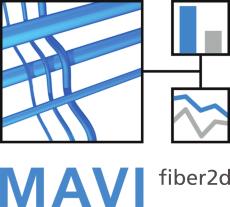
MAVIfiber2d is a software for geometric characterization of fiber systems based on SEM or optical microscopic images. MAVIfiber2d is particularly useful for the automatic measurement of fiber thickness based on SEM images.

MAVIfiber2d is a software for geometric characterization of fiber systems based on SEM or optical microscopic images. MAVIfiber2d is particularly useful for the automatic measurement of fiber thickness based on SEM images.
The grade of nonwoven fabrics depends on the distribution of the fiber density, fiber orientation, and the cloudiness. These properties are evaluated in the laboratory using image data. MAVIfiber2d meets the difficult challenge of automating this evaluation, while also ensuring that it is reproducible.
Fiber orientation analysis:
Cloudiness analysis:
Diffusion filters have been the nucleus of image processing at ITWM and the VQC project, which measured the cloudiness of nonwovens and was one of the first industry projects in the image processing department. MAVIfiber2d combines this experience with new tools of mathematical morphology and the typical point concept of stochastic geometry to create software for objective, reproducible evaluations of nonwoven samples.
In a random closed set, the typical point concept makes it possible to measure the density and distribution of fiber orientation without having to separate the fibers in the image. In unclear situations, it is not necessary to decide where each intersecting or looped fiber begins or ends. Rather a simple binarization suffices: for every image pixel, a decision is made as to where it belongs in the fiber system, i.e., the foreground or the background. Local density and orientation are defined for every foreground pixel. The result is an area-weighted distribution of density and orientation.
Cloudiness is mathematically not that clearly defined. MAVIfiber2d builds on the VQC project findings. The input image is smoothed stepwise by approximated Gauss filters. The grayscale variances of the normalized filtered images reflect the cloudiness for the scale under consideration. The cloudiness index is calculated from the variances as a weighted average. The scales and weights are chosen such that measuring results meet as well as possible both the technical requirements and the subjective visual impression.